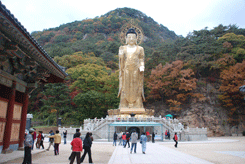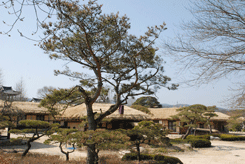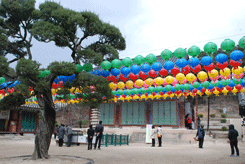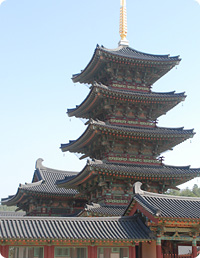EXCURSIONS
Andong / Songnisan 3 days



Tour Highlights
- Sosuseowon Confucian Academy
- Ginseng Market
- Andong Folk Museum
- Hahoemaeul Village
- Beopjusa Temple
- Hwaseong Fortress
Click on the days to access the program quick
| Days | Visits and Activities | Distance |
| Day 1 | Seoul - Yeongju - Punggi - Andong | 280km |
| Day 2 | Andong - Songnisan | 140km |
| Day 3 | Songnisan - Suwon - Seoul | 200km |
Day 1 Seoul - Andong (- - -) 280km
 Your tour guide greets you in your hotel lobby and takes you on a countryside excusion. Andong is a stronghold of Confucianism that has deeply influenced the lives of Koreans in all aspects. Stopping en route at Sosuseowon - the first private institute established in Korea, and was a birthplace of Confucian education and a cradle of prominent scholars. It was established by Ju Se-bung in 1543 and named Baekundong Seowon. The compound itself is composed of two sections; academic studies and research, and memorial service. There are several old buildings where scholars learned and studied loyalty, filial piety, manners and knowledge. The institute has a Shrine, which was built to enshrine An Hyang, An Bo, An Chuk and Je Se-bung, where a memorial service takes place twice a year on the first day of the third and ninth months by the lunar calendar.
Your tour guide greets you in your hotel lobby and takes you on a countryside excusion. Andong is a stronghold of Confucianism that has deeply influenced the lives of Koreans in all aspects. Stopping en route at Sosuseowon - the first private institute established in Korea, and was a birthplace of Confucian education and a cradle of prominent scholars. It was established by Ju Se-bung in 1543 and named Baekundong Seowon. The compound itself is composed of two sections; academic studies and research, and memorial service. There are several old buildings where scholars learned and studied loyalty, filial piety, manners and knowledge. The institute has a Shrine, which was built to enshrine An Hyang, An Bo, An Chuk and Je Se-bung, where a memorial service takes place twice a year on the first day of the third and ninth months by the lunar calendar.
While in Punggi, experience Ginseng market. There are small stalls in the building type market, all of which has piles of fresh ginseng roots, ginseng preserved in wine in fancy bottles, dried ginseng, tea, extract, candy, and honey ginseng slices. This mysterious root, which has a good smell better than it tastes, has historically been considered an empowering medicine and a cure-all; effective in recovering the liver's functions, improving anticancer and immunity functions, and treating diabetes, hypertension, low blood pressure and stress. Ginseng also facilitates recovery from fatigue and the activation of nervous cells. There are also many shops along the street leading out from the painfully quiet train station. Street vendors sell flowers, fruits, food stuff and home grown grains and vegetables. All these features mixed offer a rural ambience of Korea's remote town.
Tour also includes Andong Folk Museum offering in-depth information of traditional life and illustrating traditional Confucian culture. The museum exhibits a variety of legacies relating mainly to four cardinal ceremonies, coming of an age, wedding, funeral, ancestral memorial service, as well as dozens of pieces of pottery, utensils, clothing, farming tools and traditional folk games in small models.
Day 2 Andong - Songnisan (B) 140km
You will explore UNESCO World Heritage Site, Hahoemaeul from the 15th century. It is the best preserved traditional village portraying and spanning the life of the Joseon Dynasty (1392-1910) and some 480 Korean traditional houses, both large and small, are still fully functioning. As you take a walk in the narrow alleys, enjoy the rustic and old charm of this unique village. You cannot possibly miss a 600-years old zelkova tree, the home to the village spirit. At the tree's base is where residents still make their wishes. The village is also known for traditional festival, Hahoe Mask Dance which gave common people the opportunity to mock those in authority, and in particular the Byeolsingut, a shaman ritual exorcising evil spirits, dating back to the Goryeo dynasty (918-1392).
Travel to Songnisan national park, weaving through the picturesque countryside. En route, make a short stop at a 600-year-old pine tree shaped like an open umbrella. In recent years several branches were damaged by wind and snow, though what remains is still beautiful. Upon entering Beopjusa dating back to 553, you will certainly stand in awe as you view the enormous golden Buddha gazing down at the temple and a five-story wooden pagoda, the only one left in Korea. Check out a giant iron pot whose diameter is 2.7 meters that may well had been used to feed 3,000 priests in the early 12th century. A stone carved lantern supported by twin lions standing face to face is a rare example of the magnificent Silla sculptures. A stone water cistern is considered unique for beauty and design. Two stone pillars once held the temple banner pole. An excellent carved relief called Maaebul and worship halls also can be seen.
You cannot miss Four Buddhist Instrument Ceremony. The sounds of each instrument, Brahma bell, Dharma drum, wooden fish and cloud-shaped gong, have a function in saving beings of other realms. Hearing them reverberating through the universe, you will reflect upon the profound symbolism of the instruments. It is a great vow to save or enlighten the creatures in the universe including those on land, in the sea, in the air and in hell.
Day 3 Songnisan - Suwon - Seoul (B) 200km
En route, visit UNESCO World Heritage site of Hwaseong Fortress from the 18th century. Though it is relatively small in scale, it is well acknowledged as the best structure of its kind ever built in Korea. A 5.74km-long fortress enclosing both flatland and hilly terrain is parapeted with crenels and merlons and highlighted by four main gates and well over 50 structures including temporary palace where the king sought refuge during war and found rest during times of peace. A walk through the whole fortress could take several hours but it is well worth making a short walking tour to enjoy the splendor of the fortress, including the Korea's largest Janganmun Gate.






